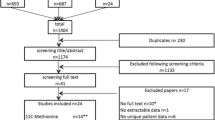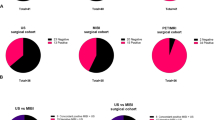Abstract
Purpose
The aim of this study was to assess the clinical value of [11C]methionine-PET (MET-PET) for detection and localization of parathyroid adenomas in patients without prior thyroidectomy.
Methods
A retrospective analysis of patients with suspected parathyroid adenomas undergoing imaging with MET-PET was performed. Prior thyroidectomy was an exclusion criterion. Forty-one patients with a total of 49 MET-PET scans were included. MET-PET consisted of whole-body images obtained 15–20 min after injection of 430 ± 81 MBq of MET using a dedicated PET scanner. Imaging findings were validated by histology or other imaging studies and clinical follow-up on a lesion, side, and location basis. Comparison of PET results to other imaging modalities including ultrasound, MIBI scintigraphy, and morphological imaging [computed tomography (CT) and/or magnetic resonance imaging] and subgroup analysis of primary vs. secondary hyperparathyroidism was performed.
Results
Twenty-three of 49 PET scans revealed pathologic findings, whereas 26 of 49 scans were negative. Validation of PET findings for detection and localization of parathyroid adenomas resulted in an overall sensitivity of MET-PET of 54%, 49%, and 35% on a lesion, side, and location basis, respectively. Sensitivity of MET-PET was inferior compared to ultrasonography (50% vs. 93%), MIBI scintigraphy (53% vs. 74%) and morphological imaging (52% vs. 74%). Subgroup analysis revealed higher sensitivity for MET-PET in secondary HPT (sHPT) than primary HPT (pHPT; 62% vs. 43%; side basis).
Conclusions
In patients with initial diagnosis of hyperparathyroidism and no prior thyroidectomy, the sensitivity of MET-PET for detection and localization of parathyroid adenomas is markedly lower compared to previous reports. While performance was better in sHPT, we believe that MET-PET cannot be recommended for pHPT localization in this clinically relevant subcollective. The clinical value of MET/PET in patients with hyperparathyroidism should be further investigated in a prospective study utilizing anatometabolic imaging with a PET/CT device.



Similar content being viewed by others
References
Johnson NA, Tublin ME, Ogilvie JB (2007) Parathyroid imaging: technique and role in the preoperative evaluation of primary hyperparathyroidism. AJR Am J Roentgenol 188:1706–1715
Bergenfelz A, Lindblom P, Tibblin S, Westerdahl J (2002) Unilateral versus bilateral neck exploration for primary hyperparathyroidism: a prospective randomized controlled trial. Ann Surg 236:543–551
Lorenz K, Miccoli P, Monchik JM, Duren M, Dralle H (2001) Minimally invasive video-assisted parathyroidectomy: multiinstitutional study. World J Surg 25:704–707
Otto D, Boerner AR, Hofmann M, Brunkhorst T, Meyer GJ, Petrich T, Scheumann GF, Knapp WH (2004) Pre-operative localisation of hyperfunctional parathyroid tissue with 11C-methionine PET. Eur J Nucl Med Mol Imaging 31:1405–1412
Sundin A, Johansson C, Hellman P, Bergstrom M, Ahlstrom H, Jacobson GB, Langstrom B, Rastad J (1996) Pet and parathyroid l-[carbon-11]methionine accumulation in hyperparathyroidism. J Nucl Med 37:1766–1770
Beggs AD, Hain SF (2005) Localization of parathyroid adenomas using 11C-methionine positron emission tomography. Nucl Med Commun 26:133–136
Hellman P, Ahlstrom H, Bergstrom M, Sundin A, Langstrom B, Westerberg G, Juhlin C, Akerstrom G, Rastad J (1994) Positron emission tomography with 11C-methionine in hyperparathyroidism. Surgery 116:974–981
Hessman O, Stalberg P, Sundin A, Garske U, Rudberg C, Eriksson LG, Hellman P, Akerstrom G (2008) High success rate of parathyroid reoperation may be achieved with improved localization diagnosis. World J Surg 32:774–781
Gotthardt M, Lohmann B, Behr TM, Bauhofer A, Franzius C, Schipper ML, Wagner M, Hoffken H, Sitter H, Rothmund M, Joseph K, Nies C (2004) Clinical value of parathyroid scintigraphy with technetium-99m methoxyisobutylisonitrile: discrepancies in clinical data and a systematic metaanalysis of the literature. World J Surg 28:100–107
Gonen M, Panageas KS, Larson SM (2001) Statistical issues in analysis of diagnostic imaging experiments with multiple observations per patient. Radiology 221:763–767
Ong SC, Schoder H, Patel SG, Tabangay-Lim IM, Doddamane I, Gonen M, Shaha AR, Tuttle RM, Shah JP, Larson SM (2007) Diagnostic accuracy of 18F-FdG PET in restaging patients with medullary thyroid carcinoma and elevated calcitonin levels. J Nucl Med 48:501–507
Ramos CD, Erdi YE, Gonen M, Riedel E, Yeung HW, Macapinlac HA, Chisin R, Larson SM (2001) FDG-PET standardized uptake values in normal anatomical structures using iterative reconstruction segmented attenuation correction and filtered back-projection. Eur J Nucl Med 28:155–164
Yamamoto F, Tsukamoto E, Nakada K, Takei T, Zhao S, Asaka M, Tamaki N (2004) 18F-FDG PET is superior to 67 Ga SPECT in the staging of non-Hodgkin’s lymphoma. Ann Nucl Med 18:519–526
Altman D (1998) Some common problems in medical research. Practical statistics for medical research. Chapman & Hall, London, pp 403–409
Gooding GA, Clark OH (1992) Use of color Doppler imaging in the distinction between thyroid and parathyroid lesions. Am J Surg 164:51–56
Rickes S, Sitzy J, Neye H, Ocran KW, Wermke W (2003) High-resolution ultrasound in combination with colour-Doppler sonography for preoperative localization of parathyroid adenomas in patients with primary hyperparathyroidism. Ultraschall Med 24:85–89
Dankerl A, Liebisch P, Glatting G, Friesen C, Blumstein NM, Kocot D, Wendl C, Bunjes D, Reske SN (2007) Multiple myeloma: molecular imaging with 11C-methionine PET/CT—initial experience. Radiology 242:498–508
de Jong HW, van Velden FH, Kloet RW, Buijs FL, Boellaard R, Lammertsma AA (2007) Performance evaluation of the ECAT HRRT: an LSO-LYSO double layer high resolution, high sensitivity scanner. Phys Med Biol 52:1505–1526
Kanegae K, Nakano I, Kimura K, Kaji H, Kuge Y, Shiga T, Zhao S, Okamoto S, Tamaki N (2007) Comparison of MET-PET and FDG-PET for differentiation between benign lesions and lung cancer in pneumoconiosis. Ann Nucl Med 21:331–337
Acknowledgments
We appreciate the excellent contributions made by the technical staff members of the Department of Nuclear Medicine, Hokkaido University, Sapporo, Japan.
Author information
Authors and Affiliations
Corresponding author
Rights and permissions
About this article
Cite this article
Herrmann, K., Takei, T., Kanegae, K. et al. Clinical Value and Limitations of [11C]-Methionine PET for Detection and Localization of Suspected Parathyroid Adenomas. Mol Imaging Biol 11, 356–363 (2009). https://doi.org/10.1007/s11307-009-0205-4
Received:
Revised:
Accepted:
Published:
Issue Date:
DOI: https://doi.org/10.1007/s11307-009-0205-4




